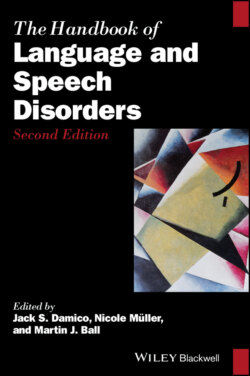Читать книгу The Handbook of Language and Speech Disorders - Группа авторов - Страница 70
5.1 Why Study Genetic Syndromes?
ОглавлениеA syndrome is defined as the presence of multiple anomalies in the same individual with all of those anomalies having a single cause. Different motivations have driven the study and research into genetic syndromes. One strong motivation has been to obtain as much in‐depth knowledge as possible about the behavioral manifestations of a specific genetic syndrome, in order to develop better understanding of the condition and inform diagnosis and intervention. Another reason for studying genetic syndromes (the focus of this chapter) has been the potential contribution that knowledge about genetic syndromes can make to advancing theoretical debates on the role of general cognitive mechanisms for language acquisition. This is because different cognitive skills can sometimes be dissociated, resulting in neurocognitive profiles characterized by relative strengths and weaknesses. With the second reason in mind, the study of genetic syndromes has informed debates about the potential dissociability of language (primarily grammar) from other cognitive skills for the past few decades. According to the Modularity of Mind hypothesis (Fodor, 1983), many of the processes involved in language comprehension are undertaken by special neural systems called modules, whose main feature is informational encapsulation, which means they only have access to certain types of information. For example, a breakdown in the visual system should not affect a person’s processing of tense marking morphology. According to this view, the modular system observed in the adult end state is also present in the infant start state. This view has been challenged, one of the challenges being that modules are not specified innately and that the mind becomes modularized in the process of development under the influence of the environment (Karmiloff‐Smith, 1994, 1998). This view is known as neuro‐constructivism. Developmental disorders provide a naturalistic way of testing the relation between the biological (and psychological) basis of language and the biological (and psychological) basis of other cognitive or neural systems (Marcus & Rabagliati, 2006).
A related issue, which has featured prominently in debates about modularity, is whether cognitive development, including language, in individuals with genetic syndromes follows a developmental trajectory which mirrors the one seen in typical development, or whether due to the genetic abnormality and the consequently altered environment, the developmental trajectory may be atypical. If we assume the innate modularity view, one would predict that language and general cognitive development in populations affected by genetic disorders follow a developmental trajectory that mirrors the one seen in typical development (Pinker, 1999), although one or more components of this system may be anomalous. If we assume the neuro‐constructivist view, then we would predict that a genetic abnormality inevitably affects the developmental pathway, such that development proceeds along an atypical trajectory.
Although it is well established that many genetic syndromes are associated with communication disorders, there is still a large number of disorders for which there is no information available. The six best‐known genetic syndromes as far as language and communication are concerned are: Down syndrome (DS), Williams syndrome (WS), Fragile‐X syndrome, Prader‐Willi syndrome, Cri‐du‐chat syndrome, and Noonan syndrome (Rondal, 2001). This chapter will focus on WS and DS because these syndromes have been particularly implicated in theoretical debates about the status of language within human cognition and also because they have informed debates on innate modularity and neuro‐constructivism.
